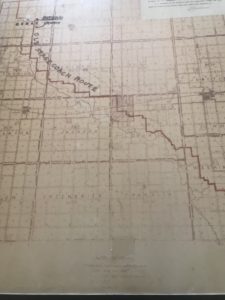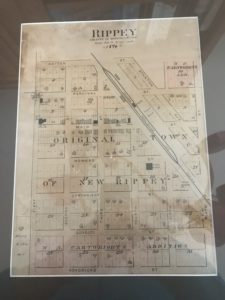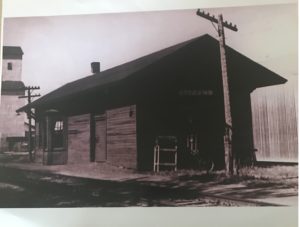What Do You Remember About Rippey?
The Rippey, Iowa, Sesquicentennial will be held on Saturday, August 1, 2020. If you have personal remembrances of Rippey, you are invited and encouraged to share those memorable stories. Just send your remembrance via email and we’ll get it posted on the Rippey News Web site, as well as on Facebook sites of the Friends of Rippey and the Rippey Sesquicentennial. You write down the anecdote or story–a page or two–and we’ll do the rest. Phyllis McElheney Lepke is serving as our volunteer coordinator and stories may be sent to her at Rippey150@gmail.com.
Old Rippey Moves To The Railroad Submitted by Mary Dorris Weaver
Newspaper quote provided by Jean Darling Borgeson
The original Rippey began in 1855 when the Davis, Hardin, and Buttrick families and several others arrived and formed a neighborhood cluster of early pioneers along the North Raccoon River in southeastern Greene County.
The stagecoach from Des Moines to Fort Dodge, and eventually to Sioux City, ran through the town, as the trail essentially followed the Raccoon River across Greene County from southeast to northwest. The stagecoach ran through original Rippey from 1850-1866.
New Rippey was laid out in 1870 by William Cartwright as an employee of the Des Moines Valley Railroad.
The first homes in Rippey were moved from Coal Town, later called Angus, and Surrey. Both were coal mining communities that were abandoned as the coal supply diminished. Surrey, or Surry as it is sometimes spelled, is no longer visible, but was located three and one half miles south of Rippey, and one half mile east.
Jefferson Bee, Friday, April 28, 1871; pg. 3 Al Swaim, Editor & Proprietor
Rippey Station—The manner in which New Rippey has been taken with the fever of improvement of late is gratifying, and that we shall soon have a fair-sized community of industrious people gathered together there, promises most details. The improvements are marks that bring gratification to everyone who desires the thousands of untilled acres to bloom and blossom as the gardens of the storied past. Our domain is wide, healthy and fruitful, and that its advantages are being well canvassed and fell in with, we have only to point to the numberless farms now being open and to the white covered wagons and tents dotting the green prairie in almost every part of the county.
Mr. Cartwright was an investor who resided in Mediapolis, Iowa, and had purchased about 40 acres of land on either side of the railroad in and around Rippey. The railroad was called the Des Moines Valley Railroad, later to become the Des Moines and Fort Dodge and eventually the Minneapolis/St Louis. (M and St. L.).
Passenger services, from all research of older newspapers, began in May of 1869. We have documentation the passenger train carried soldiers to the Spanish American War, but the permanent depot was not built until 1872. It was built of wood and painted red, and sat on the east side of the railroad tracks, just north of Main Street. It had three rooms, a waiting room, a telegraph office and a freight room. There were outside pens for livestock south of the depot. The only interior furnishings were the heavy wooden slatted seats with iron legs and arm rests. These seats were arranged around the outside of the room, which was heated by a pot-bellied stove that burned coal and stood in a shallow wooden box which was partly filled with ashes. This served to catch any embers which might fall from the stove door. The room was lighted by oil-filled lamps on side brackets.
The railroad did a thriving business with passengers and car-load shipments of grain, livestock, and coal.
Passenger service reached its peak in 1912 when there were four passenger trains each way daily, which included a night train with a sleeping car.
In the paper issued on Thursday July 9, 1925, “Rippey News” shows this passenger rail schedule:
North Bound No. 209 1:50 P.M.
No. 205 6:59 P.M.
South Bound No. 206 4:59 P.M.
No. 210 8:48 A.M.
An ad was also in the newspaper encouraging the purchase of tickets for the Iowa State Fair and to ride the train to the Fair.
Part of the mystique of visiting the depot was watching and listening to the telegraph. Its primary use was for sending train orders, but before the telephone it was the only way important messages could be shared. Every agent had to master the Morse Code. The election returns came by telegram to the depot and huge the crowds would gather on election night, eager to learn the outcome.
The last passenger service was April 1959.
The depot was torn down and the lumber burned in 1963.
REMINDER DATES:
IOWA BECAME A STATE IN 1846
TRUMAN DAVIS AND FAMILY ARRIVED IN 1849
GREENE COUNTY ESTABLISHED IN 1851
THE CIVIL WAR BEGAN IN 1861
MODEL T CAR 1st MANUFACTURED IN 1908
WWI 1914-1918, U.S. ENTERED 1917
GREENE COUNTY COURTHOUSE BUILT IN 1919
RIPPEY CONSOLIDATED SCHOOL BUILT IN 1921
Research sources:
Past and Present of Greene County, Iowa, E.B.Stillman, 1907
The Globe Free Press Centennial Edition July 1969
History of Rippey, Greene County, Iowa 1849-1956
The History of Rippey, Greene County, Iowa 1849-1970
Tales of Old Rippey School Told, Jefferson Herald 1954
Photocopy of the Plat of Town of Rippey, February 28, 1855,
signed by R.M. Rippey, Surveyor and Civil Engineer



